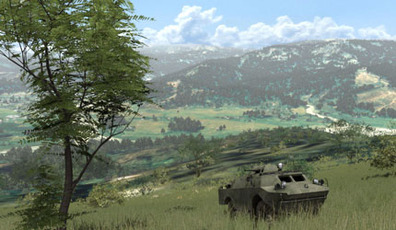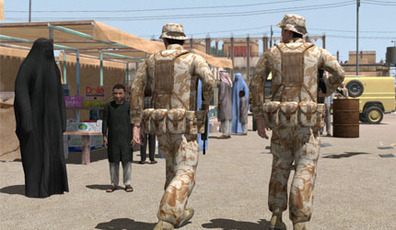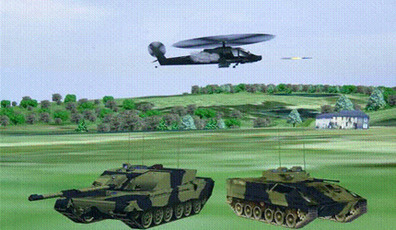
This week I've performed a stop and search patrol in downtown Baghdad, escorted a convoy of trucks through Basra and taken part in a heliborne assault on a Taliban stronghold in Afghanistan.
Fortunately I didn’t get a scratch though, as contrary to the rumour going round the office I haven’t signed up for a tour of duty with a mercenary company - I’ve been taking part in these real-world conflicts on my PC using VBS2.
[break]
Virtual Battlespace 2, or VBS2 to its friends, is a battlefield simulator developed by Bohemia Interactive Australia, the sister company of Bohemia Interactive, the developers of Operation Flashpoint and Arma: Armed Assault. However, although OFP and Arma are a good deal more realistic than most games, I’d hesitate to describe VBS2 as a game.

VBS2 is based on the same graphics engine as the game Arma: Assault Assault.
For starters, up until a couple of months ago you had to be a government organisation with a multi-million dollar IT budget such as the US Marine Corps or the British Ministry of Defence to even buy a copy of VBS2. That all changed recently though, as BIA decided it was okay to sell a version of VBS2 direct to consumers. At £275, VBS2 Personal Edition is still a lot more expensive than a typical PC game, but being the sort of person who enjoys arguing the merits of the seven different marks of Sten gun, I thought it worth taking for a spin.
Apart from the eye-watering price a number of things quickly become apparent when you try VBS2 for the first time. For starters, because even the cut-down Personal Edition version includes so many different units and maps it's supplied on two DVDs. Secondly, like some professional graphics applications VBS2 PE is supplied with a USB dongle. This comes in a variety of colours, depending on the length and type of license you have purchased and prevents the simulation from loading without it being inserted in a USB port.
My first experience of VBS2 PE didn’t get off to particularly good start. Like most gamers I’m used to clicking on the game icon in the Start menu and then diving in. With VBS 2 PE however the default icon loads a ‘rights limited’ version of the simulation. In this mode you can’t adjust any of the graphics or audio settings, let alone remap any of the controls. I suppose this is to stop squaddies messing around with the computers they run VBS2 on, but VBS2 PE is the first ‘game’ I can think of with such a limitation. A quick visit to the manual suggested trying clicking on the Administrator mode icon – which treats you like a responsible adult and unlocks all the menus.
The next hurdle is trying to find something to ‘play’. Unlike other games, even non-linear games such as Team Fortress 2, which include a lot of pre-made missions or levels, VBS2 PE is surprisingly sparse. The main menu provides several options, but none are really conducive to jumping in and playing. There are a couple of training scenarios, but these are only really designed to get you used to the default controls as you navigate your avatar through an assault course.
The best menu to try is the Library – which allows you to view in 3D all the units and objects included in VBS2 PE. These vary from the insanely detailed; such as 13 different models of Warrior MICV, to the more mundane; four different breeds of dog, a tractor and a concrete mixing truck, just to name a few. The Library also allows you jump in and control any of these objects, setting you a number of different challenges, from the bizarre; racing a Challenger 2 MBT around a track, to the humdrum: shooting up a collection of trucks in your Apache attack helicopter.
The plethora of sea, air and land (both pedestrian and vehicles) units is one of the biggest differences between VBS2 PE and most games. Although VBS PE doesn’t simulate aircraft as well as Flight Sim X or boats as well as Ship Simulator it provides enough realism for soldiers from various military disciplines to train together in one giant virtual environment. This networking is hugely important, as one of the most crucial parts of training is teaching soldiers to work together as a unit. A virtual battlefield simulator such as VBS2 is thus immensely useful, as it allows soldiers to train to work together without much of the cost, or risk of training out in the field.

You too can walk the streets of Baghdad and get shot at by guerillas if you want. Just be careful not to shoot any civlians.
Unless you have downloaded some user-made missions from one of the several end-user accessible VBS2 forums such as Razors Edge, you’ll need to make a mission of your own to play. This can be done in the Mission Editor, which allows you to create hugely detailed scenarios with full control of the environment including the date, time and weather. In addition to simply plonking down units onto the map you can also script them to behave in a certain way, for example to wait in ambush or patrol a certain area. If works in much the same way as the scenario editor included in Bohemia Interactive’s games, but has many more options.

You can easily make your own missions in VBS2 - in this case a recreation of the Iranian Embassy siege of 1980.
The final part of VBS2 is the After Action Review, which acts much like the 'instant replay' feature found in the TV coverage of sporting events, allowing you to view what just happened in the game world. While this provides limited amusement for gamers, for the military it’s a key feature, as it allows instructors to show the troops where they went wrong after the battle so that they learn from the experience.
Although, on the surface, VBS2 plays like pretty much any first person shooter/driving/flying game it soon becomes apparent that this is no game at all. For example, while mainstream PC games have been slow to introduce a limitation on the amount of weapons and ammo your avatar can carry around, VBS2 has a sophisticated inventory system that takes into account the weight and volume of items. No more carrying around four rifles, half a dozen rockets and a crate full of ammo then.
VBS2 is also very uncompromising when it comes to the level of difficulty. Although it’s far easier to aim and shoot with the mouse than it is to aim and fire a real assault rifle, staying alive in VBS2 is still a real challenge – the 21st century battlefield is positively crammed with sharp bits of metal flying through the air at high-speed with your name on them. While you can slow down and accelerate time if you’re fighting a single-player battle, in multiplayer missions you can’t tweak the laws of physics to help you out in this way.
As VBS2 was first made available to government users in April 2007, it doesn't have the best looking 3D engine. Still, although its graphics are several light years ahead of traditional military simulators, such as the British Army’s £400 million Combined Arms Tactical Trainer built by Lockheed Martin, it’s no Crysis. Still, the maps in Crysis are typically no more than 6,400 hectares, barely enough for a fast moving aircraft to turn around, compared to VBS2’s up to one million hectare maps.

The graphics in a traditional military simulator, such as the British Army's CATT are truly atrocious by PC game standards.
As a gamer however, even one with a strong interest in military history, VBS2 has one principal fault – it’s not much fun. This is no doubt in part due to the tiny user community – VBS2 is only really worth playing online with other people, and at £275 precious few gamers have bought VBS2.
It can be hugely rewarding to complete a tough and realistic mission, but when you can get a very similar experience from a heavily modded version of Arma for £24.99, VBS2 PE suddenly isn’t a very attractive proposition, even for a hardened military geek such as myself.
Perhaps if the developers had decided to sell VBS2 PE sooner, then it would have given more time for the price to trickle down to a more acceptable level and allow the modding community longer to get to sink its teeth into the engine’s huge potential. After all, out of the box Arma suffers from many of the same problems as VBS2 PE - but most of issues have been addressed by an extremely active modding community.
Ultimately, while VBS2 is undoubtedly a fantastic training tool, and a huge leap forward in graphical fidelity from proprietary military simulators, for gamers, VBS2 PE is an interesting but costly distraction from the wait for Arma II, due out later this year.
Fortunately I didn’t get a scratch though, as contrary to the rumour going round the office I haven’t signed up for a tour of duty with a mercenary company - I’ve been taking part in these real-world conflicts on my PC using VBS2.
[break]
Virtual Battlespace 2, or VBS2 to its friends, is a battlefield simulator developed by Bohemia Interactive Australia, the sister company of Bohemia Interactive, the developers of Operation Flashpoint and Arma: Armed Assault. However, although OFP and Arma are a good deal more realistic than most games, I’d hesitate to describe VBS2 as a game.

VBS2 is based on the same graphics engine as the game Arma: Assault Assault.
For starters, up until a couple of months ago you had to be a government organisation with a multi-million dollar IT budget such as the US Marine Corps or the British Ministry of Defence to even buy a copy of VBS2. That all changed recently though, as BIA decided it was okay to sell a version of VBS2 direct to consumers. At £275, VBS2 Personal Edition is still a lot more expensive than a typical PC game, but being the sort of person who enjoys arguing the merits of the seven different marks of Sten gun, I thought it worth taking for a spin.
Apart from the eye-watering price a number of things quickly become apparent when you try VBS2 for the first time. For starters, because even the cut-down Personal Edition version includes so many different units and maps it's supplied on two DVDs. Secondly, like some professional graphics applications VBS2 PE is supplied with a USB dongle. This comes in a variety of colours, depending on the length and type of license you have purchased and prevents the simulation from loading without it being inserted in a USB port.
My first experience of VBS2 PE didn’t get off to particularly good start. Like most gamers I’m used to clicking on the game icon in the Start menu and then diving in. With VBS 2 PE however the default icon loads a ‘rights limited’ version of the simulation. In this mode you can’t adjust any of the graphics or audio settings, let alone remap any of the controls. I suppose this is to stop squaddies messing around with the computers they run VBS2 on, but VBS2 PE is the first ‘game’ I can think of with such a limitation. A quick visit to the manual suggested trying clicking on the Administrator mode icon – which treats you like a responsible adult and unlocks all the menus.
The next hurdle is trying to find something to ‘play’. Unlike other games, even non-linear games such as Team Fortress 2, which include a lot of pre-made missions or levels, VBS2 PE is surprisingly sparse. The main menu provides several options, but none are really conducive to jumping in and playing. There are a couple of training scenarios, but these are only really designed to get you used to the default controls as you navigate your avatar through an assault course.
The best menu to try is the Library – which allows you to view in 3D all the units and objects included in VBS2 PE. These vary from the insanely detailed; such as 13 different models of Warrior MICV, to the more mundane; four different breeds of dog, a tractor and a concrete mixing truck, just to name a few. The Library also allows you jump in and control any of these objects, setting you a number of different challenges, from the bizarre; racing a Challenger 2 MBT around a track, to the humdrum: shooting up a collection of trucks in your Apache attack helicopter.
The plethora of sea, air and land (both pedestrian and vehicles) units is one of the biggest differences between VBS2 PE and most games. Although VBS PE doesn’t simulate aircraft as well as Flight Sim X or boats as well as Ship Simulator it provides enough realism for soldiers from various military disciplines to train together in one giant virtual environment. This networking is hugely important, as one of the most crucial parts of training is teaching soldiers to work together as a unit. A virtual battlefield simulator such as VBS2 is thus immensely useful, as it allows soldiers to train to work together without much of the cost, or risk of training out in the field.

You too can walk the streets of Baghdad and get shot at by guerillas if you want. Just be careful not to shoot any civlians.
Unless you have downloaded some user-made missions from one of the several end-user accessible VBS2 forums such as Razors Edge, you’ll need to make a mission of your own to play. This can be done in the Mission Editor, which allows you to create hugely detailed scenarios with full control of the environment including the date, time and weather. In addition to simply plonking down units onto the map you can also script them to behave in a certain way, for example to wait in ambush or patrol a certain area. If works in much the same way as the scenario editor included in Bohemia Interactive’s games, but has many more options.

You can easily make your own missions in VBS2 - in this case a recreation of the Iranian Embassy siege of 1980.
The final part of VBS2 is the After Action Review, which acts much like the 'instant replay' feature found in the TV coverage of sporting events, allowing you to view what just happened in the game world. While this provides limited amusement for gamers, for the military it’s a key feature, as it allows instructors to show the troops where they went wrong after the battle so that they learn from the experience.
Although, on the surface, VBS2 plays like pretty much any first person shooter/driving/flying game it soon becomes apparent that this is no game at all. For example, while mainstream PC games have been slow to introduce a limitation on the amount of weapons and ammo your avatar can carry around, VBS2 has a sophisticated inventory system that takes into account the weight and volume of items. No more carrying around four rifles, half a dozen rockets and a crate full of ammo then.
VBS2 is also very uncompromising when it comes to the level of difficulty. Although it’s far easier to aim and shoot with the mouse than it is to aim and fire a real assault rifle, staying alive in VBS2 is still a real challenge – the 21st century battlefield is positively crammed with sharp bits of metal flying through the air at high-speed with your name on them. While you can slow down and accelerate time if you’re fighting a single-player battle, in multiplayer missions you can’t tweak the laws of physics to help you out in this way.
As VBS2 was first made available to government users in April 2007, it doesn't have the best looking 3D engine. Still, although its graphics are several light years ahead of traditional military simulators, such as the British Army’s £400 million Combined Arms Tactical Trainer built by Lockheed Martin, it’s no Crysis. Still, the maps in Crysis are typically no more than 6,400 hectares, barely enough for a fast moving aircraft to turn around, compared to VBS2’s up to one million hectare maps.

The graphics in a traditional military simulator, such as the British Army's CATT are truly atrocious by PC game standards.
As a gamer however, even one with a strong interest in military history, VBS2 has one principal fault – it’s not much fun. This is no doubt in part due to the tiny user community – VBS2 is only really worth playing online with other people, and at £275 precious few gamers have bought VBS2.
It can be hugely rewarding to complete a tough and realistic mission, but when you can get a very similar experience from a heavily modded version of Arma for £24.99, VBS2 PE suddenly isn’t a very attractive proposition, even for a hardened military geek such as myself.
Perhaps if the developers had decided to sell VBS2 PE sooner, then it would have given more time for the price to trickle down to a more acceptable level and allow the modding community longer to get to sink its teeth into the engine’s huge potential. After all, out of the box Arma suffers from many of the same problems as VBS2 PE - but most of issues have been addressed by an extremely active modding community.
Ultimately, while VBS2 is undoubtedly a fantastic training tool, and a huge leap forward in graphical fidelity from proprietary military simulators, for gamers, VBS2 PE is an interesting but costly distraction from the wait for Arma II, due out later this year.

MSI MPG Velox 100R Chassis Review
October 14 2021 | 15:04





Want to comment? Please log in.